Advertisements
Advertisements
प्रश्न
Find the area of each of the following figure:
उत्तर
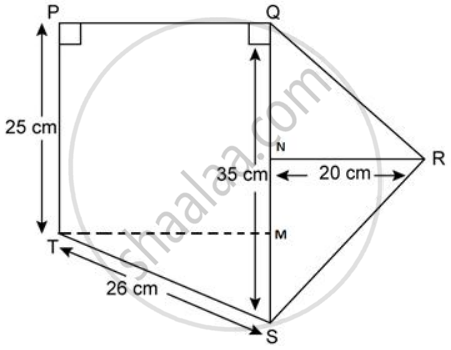
Construction: Draw TM ⊥ QS
Area of ΔRQS
= `(1)/(2) xx "QS" xx "RN"`
= `(1)/(2) xx 35 xx 20`
= 350cm2
Now,
S = QM + MS
⇒ 35 = 25 + MS
⇒ MS = 10cm
In ΔSTM,
MS2 + TM2 = ST2
⇒ TM2 = ST2 - MS2
= (26)2 - (10)2
= 676 - 100
= 576
⇒ TM
= 24cm
= PQ
Area of trapezium PQST
= `(1)/(2) xx ("PT" + "QS") xx "PQ"`
= `(1)/(2) xx (25 + 35) xx 24`
= 720cm2
Thus, area of given figure
= Area of ΔRQS + Area of trapezium PQST
=350cm2 + 720cm2
= 1070cm2.
APPEARS IN
संबंधित प्रश्न
If the diagonals of a parallelogram are equal, then show that it is a rectangle.
Diagonal AC of a parallelogram ABCD bisects ∠A (see the given figure). Show that
- It bisects ∠C also,
- ABCD is a rhombus

ABCD is a rectangle in which diagonal AC bisects ∠A as well as ∠C. Show that:
- ABCD is a square
- diagonal BD bisects ∠B as well as ∠D.
In parallelogram ABCD, two points P and Q are taken on diagonal BD such that DP = BQ (see the given figure). Show that:
- ΔAPD ≅ ΔCQB
- AP = CQ
- ΔAQB ≅ ΔCPD
- AQ = CP
- APCQ is a parallelogram
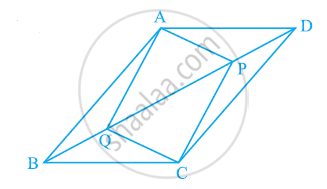
State, 'true' or 'false'
The diagonals of a quadrilateral bisect each other.
State, 'true' or 'false'
Each diagonal of a rhombus bisects it.
State, 'true' or 'false'
If two adjacent sides of a parallelogram are equal, it is a rhombus.
In the following figure, AE and BC are equal and parallel and the three sides AB, CD, and DE are equal to one another. If angle A is 102o. Find angles AEC and BCD.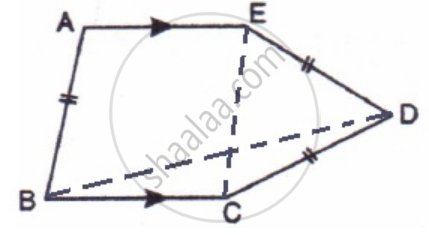
In the given figure, ST ∥ PR. Prove that: area of quadrilateral PQRS = area of ΔPQT.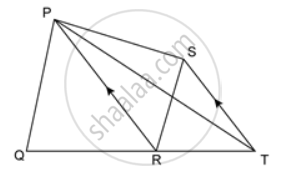
The diagonals of a parallelogram ABCD intersect at O. A line through O meets AB in P and CD in Q. Show that
(a) Area of APQD = `(1)/(2)` area of || gm ABCD
(b) Area of APQD = Area of BPQC
A quadrilateral ABCD is such that diagonals BD divides its area into two equal parts. Prove that BD bisects AC.
In the given figure, BC ∥ DE.
(a) If area of ΔADC is 20 sq. units, find the area of ΔAEB.
(b) If the area of ΔBFD is 8 square units, find the area of ΔCEF
Find the area of each of the following figure: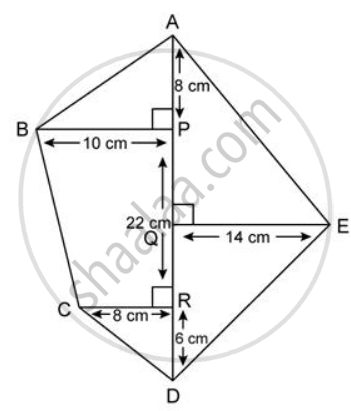
The area of a floor of a rectangular room is 360m2. If its length is 24cm, find its perimeter.
Find the area of a square whose diagonal is `12sqrt(12)"cm"`
The perimeter of a square plot of land is 64m. The area of a nearby rectangular plot is 24m2 more than the area of the given square. If the length of the rectangle is 14m, find its breadth.
Find the area of a rhombus whose perimeter is 260cm and the length of one of its diagonal is 66cm.
A rectangular field is 240m long and 180m broad. In one corner a farm house is built on a square plot of side 40m. Find the area of the remaining portion and the cost of fencing the open sides Rs.25per m.
Inside a square field of side 44m, a square flower bed is prepared leaving a graved path all round the flower bed. The total cost of laying the flower bed at Rs.25per sq m. and gravelling the path at Rs.120per sq m. is Rs.80320. Find the width of the gravel path.
